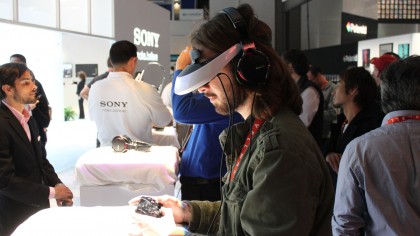Rise of the body hackers: Google, the wearable web and transhumanism
Are you happy with your body? Or is just too darned organic? The fusing of man and machine is already happening, with so-called 'body hackers' implanting cameras, brainwave sensors and magnets in their bodies to allow everything from mind-control gadgets to dreaming in sound and navigation by vibration.
For now, these experiments are the reserve of 'grinders', a small group of DIY body modifiers who design, build and test their own modifications, but they may not remain outside the mainstream for long.
Google Glass might be called revolutionary by some, but could this mass-market wearable device also be an important step in human evolution?
As a standalone gadget, the much-anticipated Explorer Edition probably won't be as mind-blowing as some might think, but it could be a catalyst for a new era where electronics are worn, and where body hacking becomes the ultimate in geek chic.
Over 485 million of us will be wearing a web-connected watch, camera, eyepiece, pacemaker or other device by 2018, according to ABI Research. The web is becoming wearable.
Are wearable gadgets socially acceptable?

Anyone who remembers seeing the first Bluetooth hands-free headsets a decade ago will recall thinking their wearers crazy lunatics - some still might - though using a smartphone in public has no such connotations.
And despite their initial rarity value, it took almost no time for tablets and ebook readers to illicit zero interest from fellow commuters. Mike Hallett, Director of Sales for North America at video headset-makers Vuzix - whose M100 eyepiece will compete with Google Glass - thinks the same will happen to eyewear.
Sign up for breaking news, reviews, opinion, top tech deals, and more.
"Many trades and leisure pursuits already accept head-mounted gear," he says, picking out head torches, intelligent ski goggles and earpieces as just some of the head enhancements already worn throughout society.
"Wearable technologies are not new, but what is are the functions of wearable devices and the form factors. As these change, eyewear will become less obtrusive to vision and will become acceptable and welcomed by everyday users."
Gowthaman Ragothaman, Chief Client Officer Asia Pacific at global media agency Mindshare, isn't so sure. "I must admit that a lot needs to be done with the head-mounted display to make the device less intrusive," he says. "It will need to be made into a fashion statement or a fashion accessory to become socially acceptable."
Are there any gadgets I can already wear?

Smartwatches like the Pebble, Martian and I'm Watch already exist - and Apple could follow suit soon - but there are a host of more interesting wearable gadgets already out there.
The market in 'wearables' is being spearheaded by fitness gadgets such as the Nike FuelBand, Fitbit One, Powerbreathe K5, Tinke and Omegawave.
Other efforts at wearables include Memeto, an always-on 'lifelogging' camera that clips to clothes and shoots an image twice a minute, automatically uploading to a smartphone app, and Larklife, a fitness-awareness armband that uses an accelerometer and Bluetooth to record your every move on a smartphone.
Google's effort at headwear might be the most anticipated, but the heads-up display has been pioneered by the likes of the Sony HMZ-T1 Personal 3D Viewer, the Vuzix M100, Oculus Rift, Epson Moverio BT-100 and the Oakley Airwave smart ski goggles.
The latter, ski goggles that present live data such as speed, altitude and time on an eyepiece in the lens, is marketed with the slogan 'straight to your brain'. For now, it's just marketing, but the use of such language is interesting in a conditioning sense - when gadgets like these actually do interact with our bodies and brains, we'll likely already be used to the idea.
How does the wearable web help the individual and wider society?

"This is a personal experience and how each person uses a product will be different, so one person may want to have constant updates on stock quotes, while another needs directions while walking, while another may want translation of signs and maps," says Hallett of eyewear and heads-up displays. "It's all about information access on the go, when you want it."

Jamie is a freelance tech, travel and space journalist based in the UK. He’s been writing regularly for Techradar since it was launched in 2008 and also writes regularly for Forbes, The Telegraph, the South China Morning Post, Sky & Telescope and the Sky At Night magazine as well as other Future titles T3, Digital Camera World, All About Space and Space.com. He also edits two of his own websites, TravGear.com and WhenIsTheNextEclipse.com that reflect his obsession with travel gear and solar eclipse travel. He is the author of A Stargazing Program For Beginners (Springer, 2015),